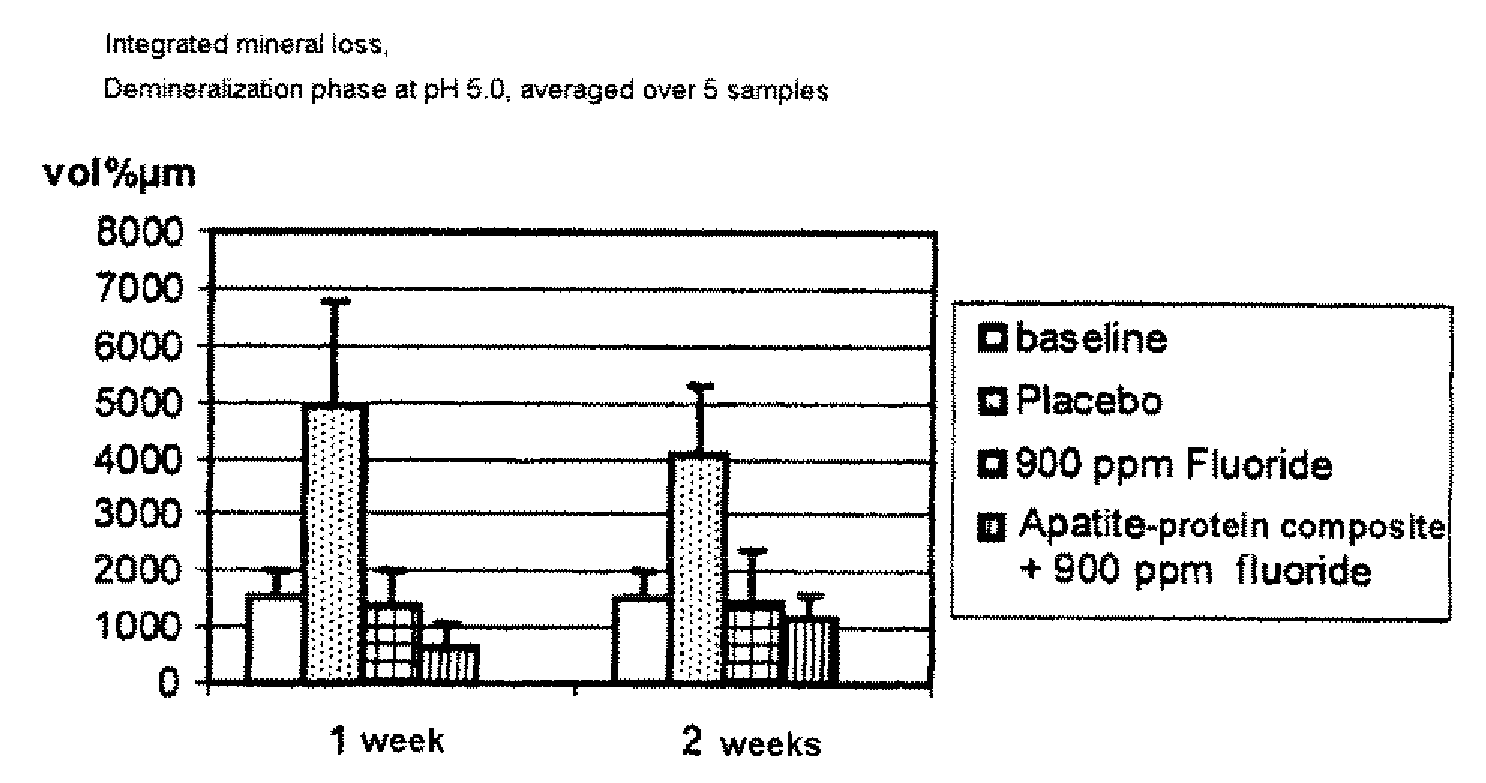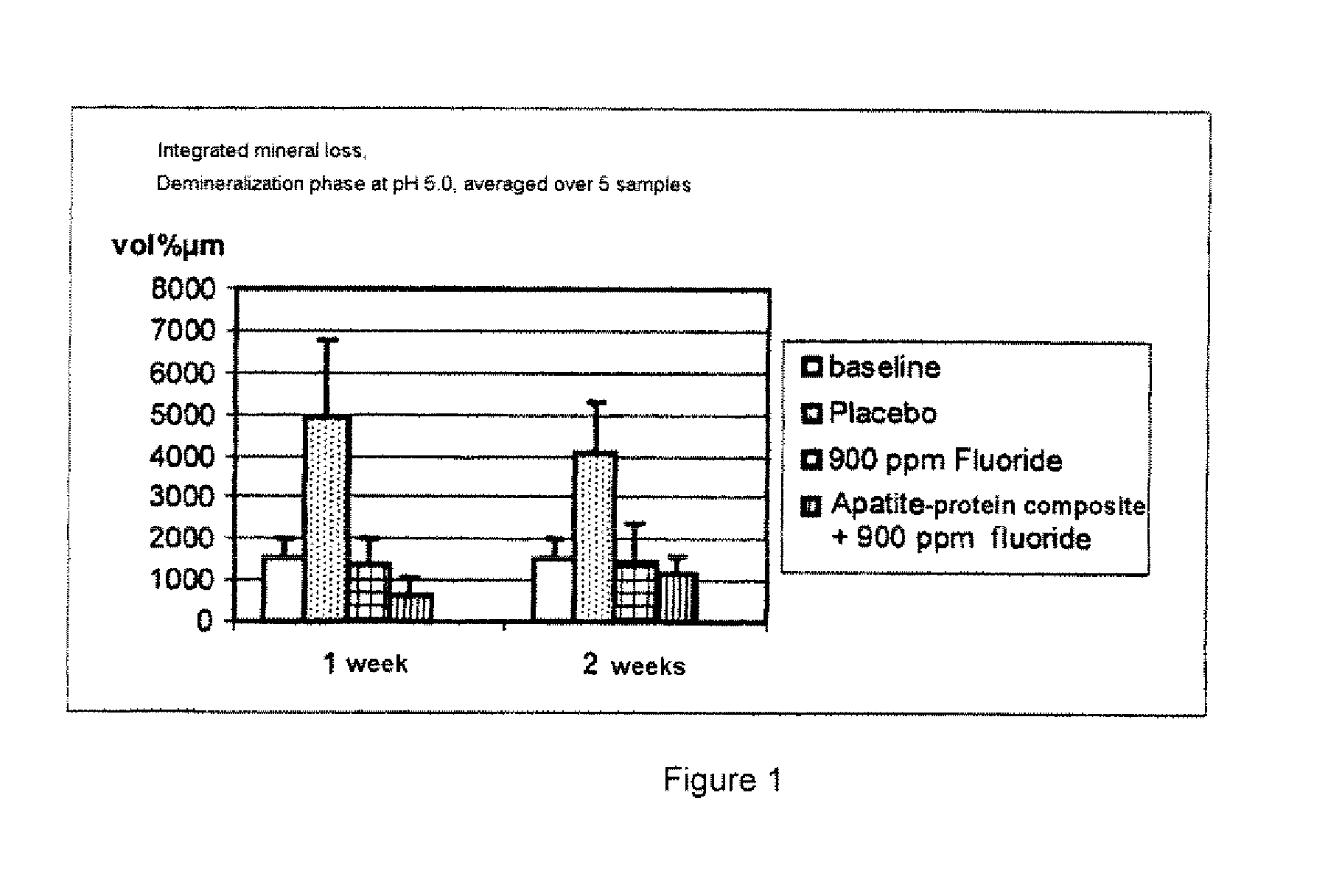Use of poorly water-soluble calcium salts and/or the composites thereof
a technology of poorly water-soluble calcium salts and composites, which is applied in the field of poorly water-soluble calcium salts and/or the composites thereof, can solve the problems of disadvantages of hydroxyapatite layers, inability to achieve satisfactory results with conventional bone substitutes, and inability to achieve small particles. , to achieve the effect of improving dental health
- Summary
- Abstract
- Description
- Claims
- Application Information
AI Technical Summary
Benefits of technology
Problems solved by technology
Method used
Image
Examples
examples
1. Production of Composite Materials by Precipitation Reactions in the Presence of the Polymer Components
1.1 Production of an Apatite-Protein Composite
[0340]For the production of the apatite-gelatin composite, 2,000 ml of deionized water are introduced into a 4 l beaker thermostated at 25° C., in which are dissolved 44.10 g (0.30 mol) of CaCl2.2H2O (Fisher Chemicals p.a.). Separately from this, 35 g of gelatin (type AB, DGF-Stoess, Eberbach) are dissolved in 350 ml of deionized water at approximately 50° C. The two solutions are combined and vigorously stirred with a propeller stirrer. The pH is adjusted to 7.0 using dilute aqueous base.
[0341]300 ml of a 0.6 M (NH4)2HPO4 solution, which had been adjusted to pH 7.0 beforehand, are uniformly pumped into this gelatin and calcium salt solution with vigorous stirring in the course of 120 min using an automated addition apparatus. In the course of this, the pH is kept constant at pH 7.0 by the controlled addition of dilute aqueous base. A...
example 9
Microhardness of Neomineralized Layers and Erosion Stability
[0371]Microhardness is a method recognized in dental research for the assessment of mineralization states of teeth in vitro (Meurman et al., Scand. J. Dent. Res. 1990 (98) 568-570). If the enamel of the tooth surface is deionized by damaging exogenous influences (erosion by acidic drinks or lesion formation due to metabolic products of bacteria), a markedly decreased microhardness is found (softened enamel).
[0372]For the measurement of the microhardness according to Knoop, pressure is exerted with a defined weight force on the enamel surface using a ground diamond in the form of a rhombic pyramid and the length of the long diagonal of the impression is measured. The hardness index can then be calculated according to a defined formula.
[0373]Study Design.
[0374]The enamel disks used for carrying out the study are prepared from front teeth of cattle. The preparations have dimensions of about 5×5 mm2. These are embedded in acryl...
example 8
[0382]In order to examine the action of the embodiment according to the invention, enamel platelets from front teeth of cattle were prepared, embedded in acrylic resin and polished. A toothpaste according to the invention was tested against a toothpaste according to the prior art. Ten samples were employed per group.
[0383]In order to attain clinically relevant conditions which were as close to reality as possible, the samples were treated in a cycling model which exposes the samples to acid stress exceeding normal nutrition habits.
[0384]The model has the following course and follows published models (ten Cate et al., Eur. J. Oral Sci., 1995: 103; 362-367).[0385]1) immersion for 5 minutes in a suspension of the respective toothpaste (1 part of toothpaste, 2 parts of water)[0386]2) storage for 25 minutes in synthetic saliva (composition according to Table 3) (37° C.)[0387]3) repetition of 1) and 2) 4 times[0388]4) acid stress for 30 minutes (lactic acid, pH 4.6)[0389]5) repetition of ...
PUM
 Login to View More
Login to View More Abstract
Description
Claims
Application Information
 Login to View More
Login to View More - R&D
- Intellectual Property
- Life Sciences
- Materials
- Tech Scout
- Unparalleled Data Quality
- Higher Quality Content
- 60% Fewer Hallucinations
Browse by: Latest US Patents, China's latest patents, Technical Efficacy Thesaurus, Application Domain, Technology Topic, Popular Technical Reports.
© 2025 PatSnap. All rights reserved.Legal|Privacy policy|Modern Slavery Act Transparency Statement|Sitemap|About US| Contact US: help@patsnap.com



